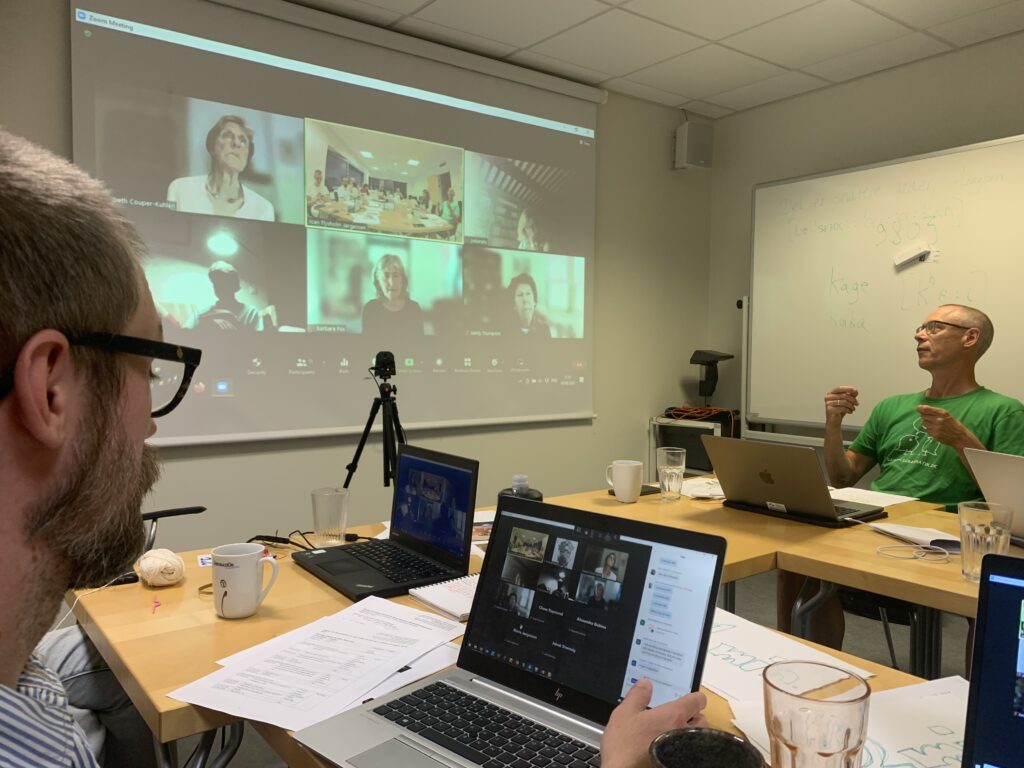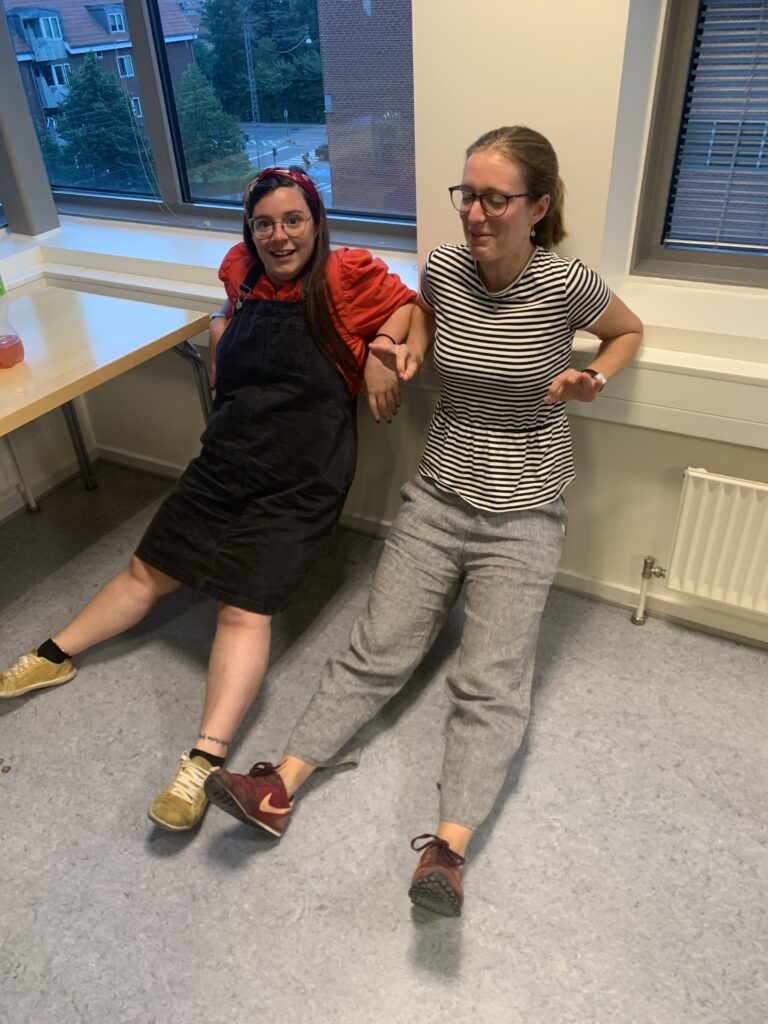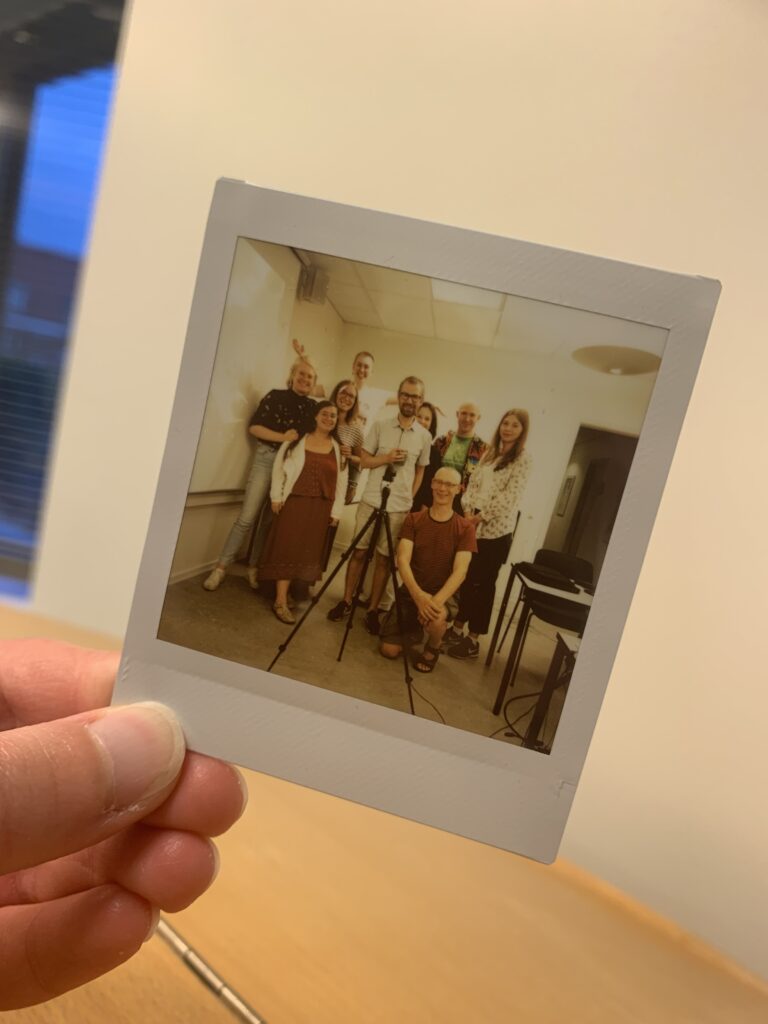by Virginia Calabria
“How and to what extent can a ‘grammar’ take important interactional features into consideration?”
“How is syntax conceived?”
“Whose abstraction is it?”
What does a group of interactional linguists end up doing when gathering in a room to answer some questions about grammar in interaction? They generate more questions than they had to begin with, of course. And they are quite happy about it, too! Top this up with chocolate, cookies, pizza… and a lot of laughs and anecdotes, and you will only begin to get the atmosphere…
On the 18 and 19 of August 2022, the “Grammar of Everyday Life” group, a.k.a. GEL, from the DanTIN (“The grammar of Danish talk-in-interaction”) research unit of Aarhus University, organized a workshop titled “From Action to Grammar”. The hybrid event took place over two intense and beautiful days, split into five sessions followed by general discussions. The aim of the workshop was twofold: discussing the permeability of the concepts of action and grammar and speculating about theoretical concepts on the basis of an array of interactional data from different languages and settings; applying these discussions, putting them into action, when building a grammar of spoken language. Why that now?

The group of researchers at Aarhus, Maria Jørgensen, Nicholas Mikkelsen and Søren Sandager Sørensen, guided by Jakob Steensig, is building the first known grammar of talk-in-interaction. Based on 50 hours of naturally occurring, everyday interactions, analyzed within the framework of interactional linguistics, the grammar, which is an ongoing, growing project, includes forms (grammatical resources), functions (actions, e.g., questions-answers, directives, etc.) and expressions and phenomena, i.e., practices, that the Danish researchers are documenting for their PhD/Post-doc projects. Moreover, they are building the grammar fully online, both in Danish and in English: https://samtalegrammatik.dk/en. Isn’t it amazing? The group that gathered for the workshop shared the same enthusiasm and expressed admiration for such an endeavor. But how does “enthusiasm” translate into the lingo of scholars? Of course, in the shape of many, many questions.
1. What’s in a grammar?
Jakob Steensig and Karita Suomalainen kicked off the workshop by presenting the practical issues linked to going from action formation to syntactic description. The main questions asked here were: can we talk about a generalizable picture of syntax? Are there cross-linguistic applications from the Danish grammar? Nicely linked to these questions came the second talk of the day, “patterns and abstractions”, by Leelo Keevallik, who by reflecting on the documented functions of a particle that she has found – at least seven – asked the questions: at which level of abstraction do you stop? Whose abstraction is it anyway? How is it all connected, and does it matter? And to close the first session, Barbara Fox and Chase Raymond reflected on the level of granularity that we need to adopt when looking at actions and formats, starting from transcription and arriving at morpho-syntax. This tied in perfectly with Leelo’s talk, reminding us that the greatness of research is its nature as work-in-progress and that we do not aim to answer every question about every topic every time: we advance knowledge one step at-a-time! One of the two great metaphors of the workshop emerged here, in the general discussion following the first session: going into granularity is like looking through a microscope, it allows different levels of magnification, and therefore different angles every time. What’s in a grammar, then? Many aspects, as well as the possibility of “discontinuing” it sometimes since grammar is only one of the aspects of the magic of interaction. This means that in building a grammar of interaction, it is ok to approach only some aspects and with some level of granularity, as prototypes and let other aspects of (the) grammar emerge with/in time.
2. What is (in) an action?
The task to answer this question was entrusted to the godmothers of IL, Betty Couper-Kuhlen and Sandy Thompson, who reflected on the gains we get from distinguishing, and refining granularly, certain actions from others, namely different types of suggestions. We learned that the importance of a ‘nominated action’ lies in its distinct features compared to similar actions, which have to do with the linguistic realization of this action, as well as its sequential position and all the recurring elements that are mobilized when carrying out the action. We were also reminded, with the second great metaphor of the workshop, that speakers have a toolbox that allows them to build actions, and that what we, researchers, do is looking at which tools they use cross-linguistically and cross-culturally to build specific actions. The general discussion led us to the consideration that actions are in a continuum; the point of ‘nominating’ them is not to have a perfect match of forms and functions, but rather to understand what speakers can achieve (and what is actually achieved) in social interaction given certain tools. Grammar enables speakers to achieve certain actions that arise from an array of contingencies and possibilities. Capturing them all is not possible but documenting some of them is progress!
3. Action to Grammar
The ‘nominated’ actions chosen to be the bridge between grammar and action were requests. Simona Pekarek Doehler spoke of inter-actional motivations behind the grammaticization of if-requests in French, while Alex Gubina presented an inventory of request formats in German, discussing the issue of prototypicality (important when choosing what to include in a grammar), and finally Jakob presented an overview of formats for doing requests in Danish, asking what goes in our grammar? Two important things emerged in the general discussion of this session: first, the other, namely the recipient, has to be in the grammar. Taking an interactional approach means considering the interactive scope of an action, not only how it is accomplished, but also how it is perceived and treated by the interlocutors. Second, as John Heritage once said: “when you enter the doctor’s practice you don’t leave your interactional tools at the door, because you’re now a patient: it’s still a conversation that works bit-by-bit”. The roles that we take on when interacting do not stop the conversation from emerging from the contingencies of the moment!
4. Grammar to Action
The other side of the coin, from grammar to action, saw the group moving from a presentation by Sophia Fiedler on the past forms of the verb denken, where we learned the relevance of aktionsart and semantic aspects of the verba sentiendi in action formation, to wh-questions in Danish by Maria Jørgensen, where clausal and phrasal response to wh-questions were found to allow speakers to achieve different actions in different sequences. It was then the turn of Karita Suomalainen, who presented the particle-like usage of Finnish kat(s)o/‘look’, reproposing the important questions, valid for all approaches that go from grammar to action: is this form only one item or several items that resemble each other? Is it multifunctionality or the same function but different form? Where do we draw the line and do participants orient to these differences? Nicely related to these questions was the talk by Søren Sandager Sørensen on copula-drop and har-drop in Danish, which, by considering phonetic, grammatic and action design, explored how assessments, agreement and accounts are achieved with copula-drop. A key take-home message here was: if we use terms like dropping and deleting, we are buying into the assumption that something should be there and it is not, which is a generative grammarians’ assumption, and not part of our linguistic heritage! The last talk was by Jan Lindström who asked whether complex syntax is used for specific purposes, bringing the example pseudo-clefts in the construction of expertise. This led the group to discuss the importance of grammatical and actional projections that allow interactional and thematic transition in conversation, in a bit-by-bit way. The general discussion concerned, among other things: whether we consider some cases ‘deviant’ and what that means when building a grammar; how much we should rely on the concepts of phrase and clause considering their cross-linguistic differences; whether frequency of occurrences has to be considered when making a comprehensive grammar. If including too much in a description brings about the issue of user-friendliness, visualizing the connections among topics should make the usage of the grammar easier.
5. Participation
There was still enthusiastic participation, despite the late hour, for the last session. Surely, having pizza for dinner (did you know that in Denmark there is a sweet pizza with mozzarella and Nutella on top? Mh… speaking of prototypicality, and what to include/accept in a collection!) helped to keep up the energy. I, Virginia Calabria, presented a talk on joining voices through hybrid other-extensions, underlining how speakers of Italian, deploying the morpho-deictic resources offered by their language, do being another speaker. Finally, Nicholas Mikkelsen wrapped it all up with a talk that touched upon many of the topics discussed during the workshop and connected them all to the questions: what’s the toolbox for doing participation? How is participation to be included in the grammar? Cecilia Ford once said that every turn provides unfolding opportunities for co-participations. During the general discussion Sandy Thompson asked the question: what is the final take-home message from this workshop? Definitely that there is more to grammar than we all think and that the task of an interactional linguist is to show that grammar is a situated resource to achieve social actions and that we can start from actions and then go back to grammar when looking at interactions: it is possible to go from Action to Grammar. Better, not only is it possible to bridge actions and grammatical formats, as the conversation analytical tradition has shown over the years, but it is also necessary, and it is representable in a grammar that aims at describing what people actually do when interacting. The point is not to try to represent everything, but to show that some practices are actually carried out systematically and that going from grammar to action and from action to grammar is the only way to render the complexity of social interactions! A future collective publication to group together the many multifaceted aspects of grammar and action brought up in only two days was discussed: we hope it will indeed see the light! We also hoped and wished for the grammar of Danish talk-in-interaction to progress in the expected directions and become the first great example of what our approach can contribute not only to the overall field of linguistics, but also to the users of a language!

It is true that probably more questions than answers were raised during the workshop, but we don’t despair: it is exactly our ability to generate these questions that progresses our fields of research… and it also gives us occasion to gather and discuss together, encompassing the sometimes solitary tasks that we carry out as researchers. The energy that gatherings like the Aarhus Workshop “From Action to Grammar” give is great fuel for future research and for the researcher, whose mind expands. I am personally gratefully and thankful for occasions like this where I grow both professionally and personally, I make new friends, I discover new food (did you know that Jakob grows very sweet grapes?), and new stretching techniques, and I make new connections in the broadest sense of this word.
To conclude with a dear quote from John Heritage: “To be socially meaningful, the meaning of actions must be shared”: thank you DAN-TIN group for sharing with us a great and meaningful workshop!


Amazing!